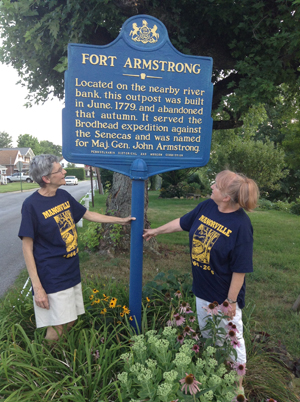Manorville Was the Site of “Fort Armstrong”

Pearl Street resident Debbie Livengood (left) and McCain Street resident Nancu Gaul read the plaque that was erected by the the Pennsylvania Historical and Museum Commission affirming the location of “Fort Armstrong.”
by David Croyle
Many local history buffs know the story of the Battle of Kittanning. The Shawnee and Delaware (Lenape) Indians had laid out a settlement that is considered the largest on the western side of the Alleghenies at that time. It is estimated that as many as 400 Indians occupied the settlement in 1756.
On September 8, 1756 during the French and Indian War, Colonel John Armstrong’s men destroyed the settlement because of the horrible acts of violence committed against the English.
Among those who were killed included Delaware Indian Captain Jacobs, who lived in a two-story log house at 313 Market Street in Kittanning.
By 1779, Fort Armstrong was built - not in Kittanning, but in Manorville. In an excerpt from the PA Magazine of History and Biography in 1891, a Catholic Priest, the Reverend A. A. Lambing - who was a descendent of the Lambing family who settled in Manorville in 1830 and engaged in milling and other occupations - wrote the following historical account of Fort Armstrong:
“As far as Fort Armstrong is concerned, it was built by Col. Stephen Bayard and completed July 1779, although there was talk of erecting a fort some three years at least before that time. It was so called in honor of General John Armstrong, who is 1756 destroyed the Indian Village of Kittanning. Bayard wished to name the fort after himself or Colonel Brodhead who commanded Fort Pitt. But the latter insisted on the name of Armstrong with a pertinacity that resulted in quite an animated correspondence on the subject between him and Colonel Bayard. The fort stood on the east bank of the Allegheny River, a little more than two miles below the present Manorville, within half a mile of where the writer of this was born. I remember seeing the old well filled with stumps. It is sometimes called a stockade fort and it was occupied permanently till the end of November in the year it was built. A block house stood about a half a mile below the fort which was torn down or fell from age about the year 1835.”
In the 1991 book on the history of Manorville, another author wrote:
“The Peter F. McClarren homestead at the corner of McClarren and Water Streets. Built about 1850, it is believed to have been built on the site of Fort Armstrong. Later owned by Mutt Ashe, then Jim Ferguson, it was removed in the 1950’s by Ferguson so that his new home could be built here.”
According the current records, Kim Huffhand lives on the former Ferguson property.
In a plaque that was erected by the Pennsylvania Historical and Museum Commission, it shows Fort Armstrong was “Located on the nearby river bank, this outpost was built in June, 1779, and abandoned that autumn. It served the Brodhead expedition against the Senecas and was named for Maj. Gen. John Armstrong.”
No Comments
No comments yet.
RSS feed for comments on this post.
Leave a comment
You must be logged in to post a comment.


